Overview
This article highlights the essential tools available for parents evaluating their children for autism spectrum disorders. Understanding the journey of seeking answers can be overwhelming, and we’re here to support you. Among the various screening and assessment instruments, the M-CHAT-R and ADOS stand out for their significant roles in early detection and intervention. These tools are not just assessments; they are gateways to better developmental outcomes for children who may be at risk of autism.
Early detection can make all the difference, fostering a nurturing environment where children can thrive. By using these instruments, parents can gain valuable insights into their child's needs, paving the way for timely support and resources. We encourage you to explore these tools and consider how they can aid in your child's developmental journey. Remember, you are not alone in this process, and seeking help is a courageous step forward.
Introduction
Understanding the complexities of autism spectrum disorder (ASD) can feel overwhelming for parents and caregivers. Navigating the evaluation process often adds to this challenge. However, the right tools can truly make a difference. They provide insights that lead to early detection and effective interventions, which are crucial for your child's development.
In this article, we will explore nine essential resources for autism spectrum test child evaluation. These resources are significant in identifying developmental challenges and fostering better outcomes.
What strategies can you employ to utilize these tools effectively, ensuring timely support for children on the spectrum?
About ASD Media: Comprehensive Resources for Autism Spectrum Testing
At ASD Media, we are deeply committed to enhancing the application of ABA therapy by providing extensive resources and insights for the autism spectrum test child. Our mission is to empower parents and professionals with the essential tools and strategies needed to navigate the complexities of evaluations related to developmental disorders. We understand the challenges you face, and by nurturing a supportive community, we ensure that individuals can share their experiences and gain valuable information.
Together, we can work towards improving outcomes for youth with ADHD. We invite you to join our community, where your voice matters, and every shared story can make a difference.
M-CHAT-R: Effective Screening Tool for Early Autism Detection
The Modified Checklist for Autism in Toddlers, Revised (M-CHAT-R) is an invaluable tool for parents, designed specifically for children aged 16 to 30 months. This widely recognized screening instrument consists of 20 targeted questions that help identify children at risk for an autism spectrum test child. It’s reassuring to know that recent studies have shown the M-CHAT-R has a pooled sensitivity of 0.83 (ranging from 75% to 95%) and a specificity of 0.94 (ranging from 75% to 95%), highlighting its reliability for both pediatricians and parents alike.
Early detection through the M-CHAT-R is crucial, as it allows for an autism spectrum test child, which opens the door for timely interventions that can significantly improve developmental outcomes. For example, children identified by the M-CHAT-R can access early support services, which are vital for nurturing social skills and addressing challenging behaviors. This instrument's effectiveness is further validated by its performance across diverse groups, including non-English speakers, where it has shown improved diagnostic accuracy.
As specialists recommend regular evaluations at 18 and 24 months, the M-CHAT-R remains a cornerstone in the early identification of developmental disorders, particularly for the autism spectrum test child. It underscores the importance of proactive measures in addressing developmental challenges. Dr. Ozonoff emphasizes this by stating, 'the M-CHAT-R is an essential resource in our efforts to recognize youngsters who may require early intervention.' This highlights the significance of the M-CHAT-R in the autism community, encouraging parents to take action for their children's well-being.
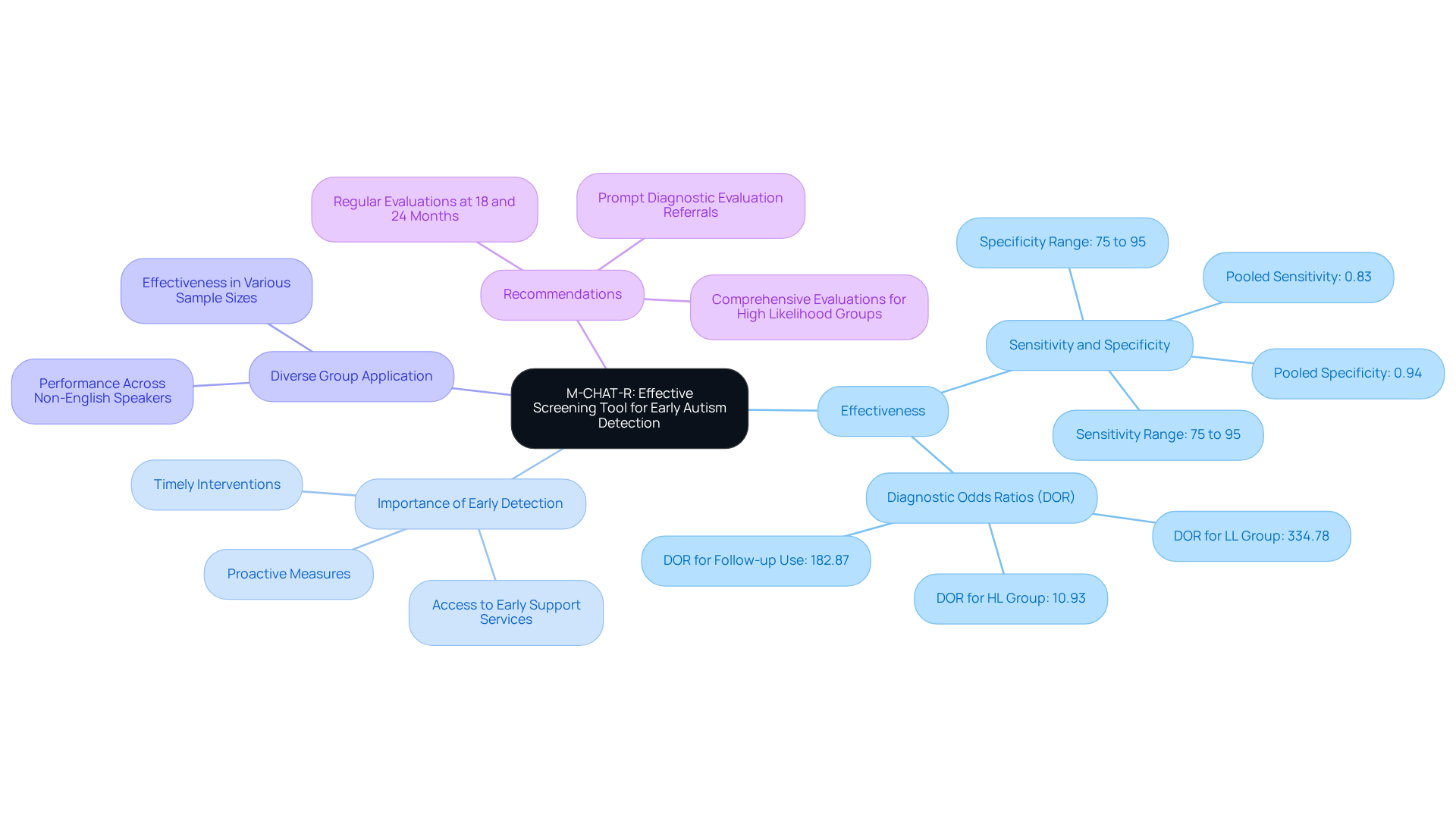
Autism Spectrum Quotient (AQ): Assessing Autism Traits in Children
The Autism Spectrum Quotient (AQ) is a self-administered questionnaire that helps evaluate the extent to which individuals display autistic traits. Primarily designed for adults, the autism spectrum test child serves as an invaluable resource for parents seeking to understand their child's behavior. The AQ sheds light on crucial areas such as social skills, communication, and repetitive behaviors, allowing for a deeper understanding of a child's unique profile. This understanding is particularly important, as research shows that autism can be reliably diagnosed by age 2, yet the average diagnosis age in the U.S. is around 5 years.
By utilizing the AQ, parents and professionals can craft targeted interventions that address specific challenges, ultimately fostering better support and development for individuals on the spectrum. Furthermore, the AQ demonstrates strong test-retest reliability and high internal consistency, making it a trustworthy autism spectrum test child for assessing traits associated with autism in children aged 4 to 11.
As the prevalence of autism spectrum disorder rises—1 in 31 children diagnosed in the U.S. and an overall ASD rate of 27.6 per 1,000 youths aged 8 years—resources like the autism spectrum test child are essential for guiding effective strategies and interventions tailored to each child's needs. If you are a parent or caregiver, consider exploring the AQ to better understand your child's unique journey and to seek the support they deserve.
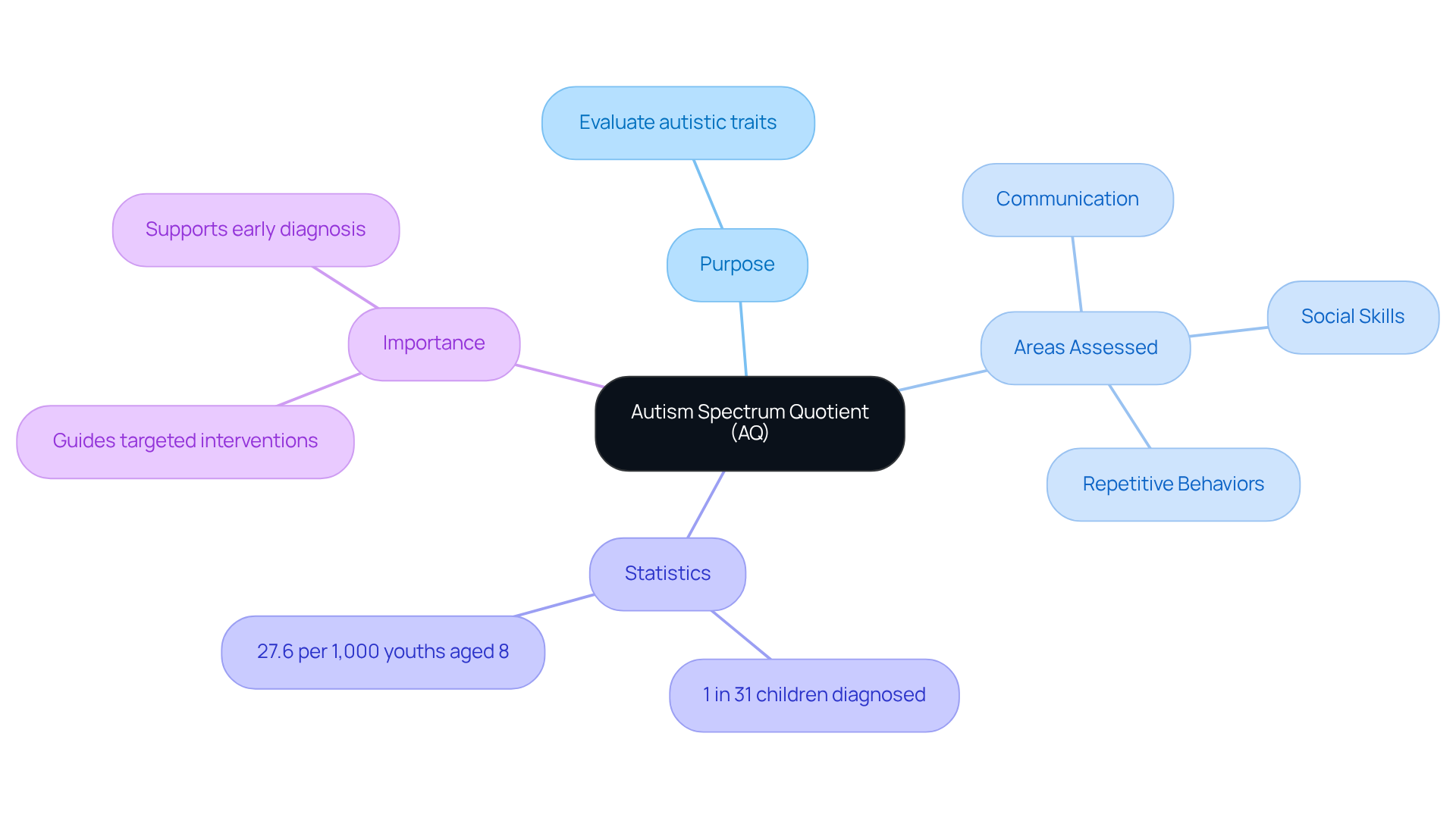
Childhood Autism Rating Scale (CARS-2): Behavioral Assessment for Autism
The Childhood Autism Rating Scale, Second Edition (CARS-2) serves as a vital tool for evaluating an autism spectrum test child. This thorough assessment looks at a child's behavior across 15 essential areas, such as social interaction, communication, and sensory responses. Recent studies have confirmed the CARS-2's effectiveness, showing a strong correlation with the Autism Diagnostic Observation Schedule (ADOS-2), widely regarded as the gold standard for diagnosing autism.
With total scores ranging from 15 to 60, the CARS-2 provides a quantitative measure of the severity of autism, where higher scores indicate a greater likelihood and intensity of the disorder. Clinicians value the structured nature of the CARS-2, which not only supports accurate diagnosis but also aids in crafting effective treatment plans. By employing the CARS-2, professionals can develop personalized interventions that cater to the unique needs of each child, ultimately improving their outcomes.
The versatility and reliability of the CARS-2 have made it a cornerstone in the assessment and intervention of developmental disorders. If you are a clinician or caregiver seeking to better understand and support a child with an autism spectrum test child, consider the CARS-2 as a key resource in your toolkit.
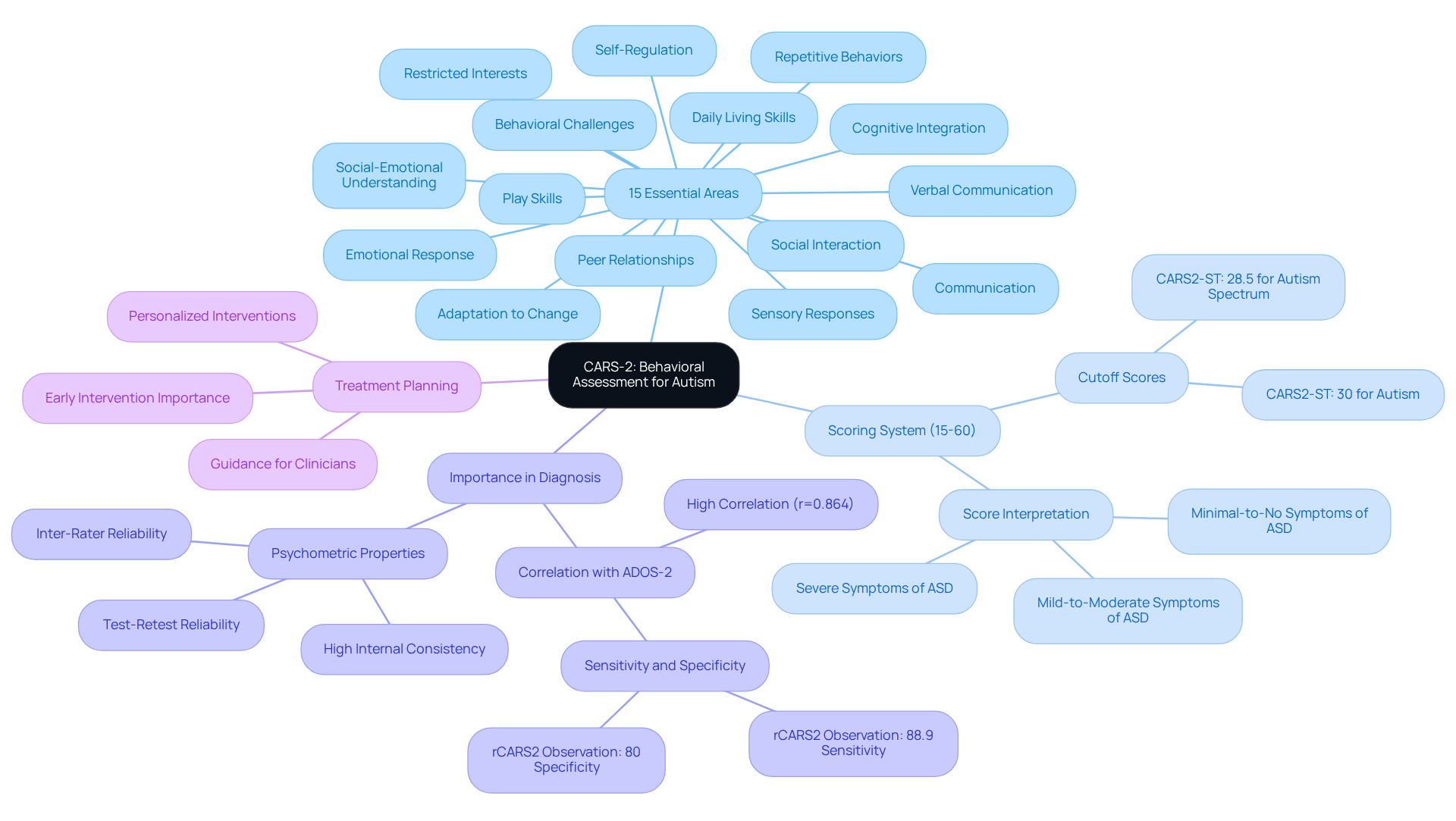
Modified Checklist for Autism in Toddlers (M-CHAT): Early Screening for Young Children
The Modified Checklist for Autism in Toddlers (M-CHAT) is a two-stage screening tool designed specifically for children aged 16 to 30 months. This parent-report questionnaire evaluates crucial behaviors associated with the autism spectrum test child, making it an essential resource for identifying children who may require further assessment. With a sensitivity of 88.6% and a specificity of 71.4%, research underscores the M-CHAT's reliability in pediatric settings.
By promoting early identification, the M-CHAT paves the way for the autism spectrum test child, leading to timely interventions that can significantly improve developmental outcomes. In fact, studies show that using the M-CHAT can lead to diagnoses occurring up to two years earlier than the national average, ultimately enhancing long-term outcomes for affected children. Its widespread use in pediatric practices highlights its effectiveness and the growing recognition of the importance of early screening for developmental disorders.
As a parent, understanding these statistics can be reassuring. Knowing that there are tools like the M-CHAT available can empower you to seek the support your child may need for an autism spectrum test child. Early action can make a world of difference, so consider discussing the M-CHAT with your pediatrician during your next visit. Your child's future is worth it.
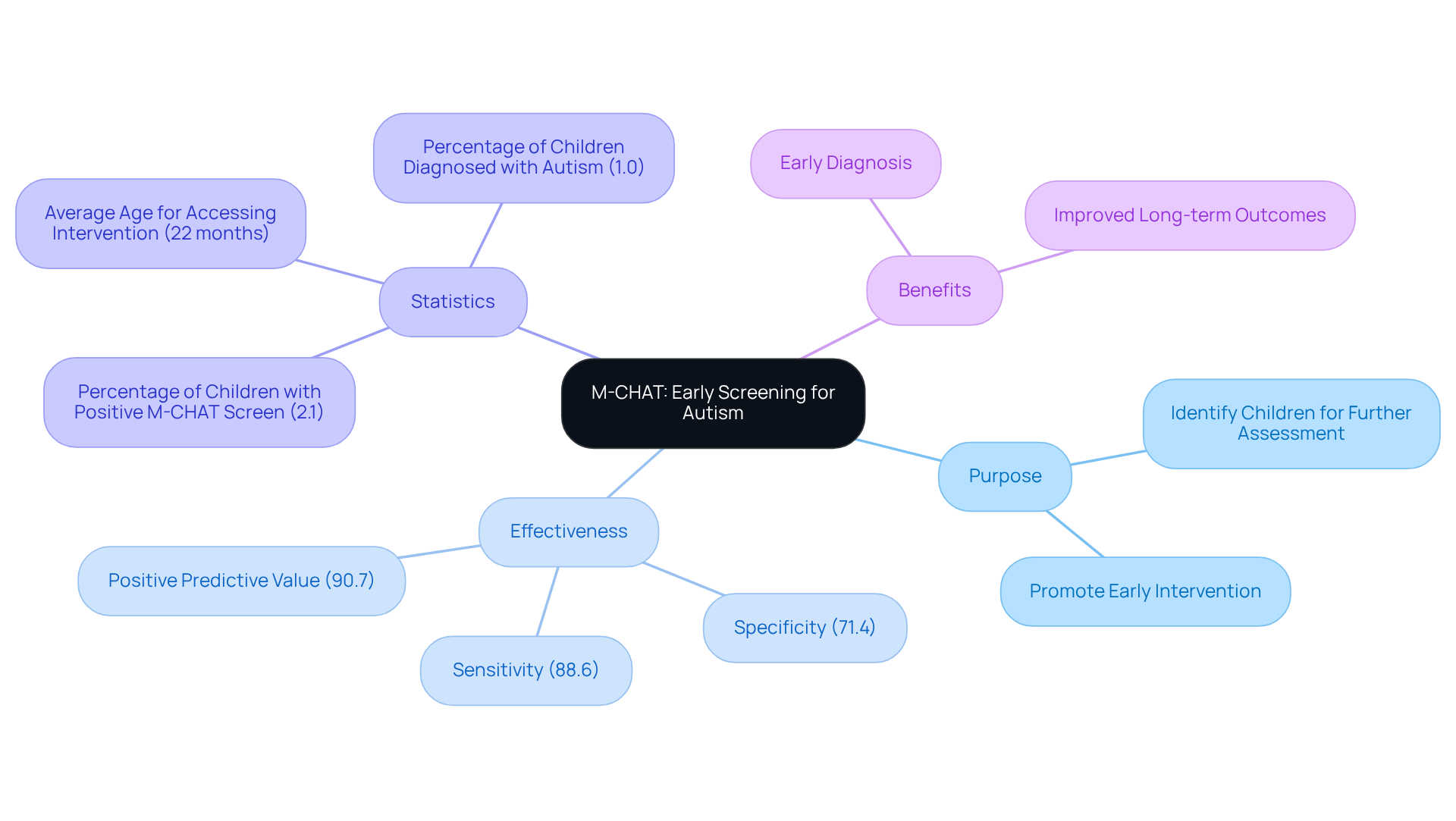
Social Responsiveness Scale (SRS): Evaluating Social Behavior in Children
Understanding your child's social behavior can be a journey filled with both challenges and hope. The Social Responsiveness Scale (SRS) is a valuable questionnaire designed to assess social behavior in young individuals, particularly those facing social impairments related to the autism spectrum test child. This tool can be completed by parents, teachers, or clinicians, providing a well-rounded perspective on your child's social interactions.
By pinpointing specific areas of difficulty, the SRS not only highlights the challenges an autism spectrum test child may encounter but also opens the door to targeted interventions. These interventions can enhance social skills and improve peer relationships, fostering a more supportive environment for your child to thrive.
As you explore the SRS, consider how it can serve as a guiding resource in your child's development. Engaging with this tool can empower you to take meaningful action, ensuring your child receives the support they need to navigate social situations with confidence. Remember, you are not alone in this journey; many parents share similar experiences and insights. Together, we can create a nurturing community focused on understanding and growth.
Autism Diagnostic Observation Schedule (ADOS): Comprehensive Autism Evaluation
Navigating the journey of understanding autism can be challenging, and the Autism Diagnostic Observation Schedule (ADOS) serves as a crucial tool in this process. This standardized assessment method allows for direct observation of a young person's behavior during structured activities and interactions, providing valuable insights into their social communication, play, and restricted behaviors. Many parents find comfort in knowing that ADOS is regarded as the gold standard for autism evaluation.
With ADOS, clinicians can conduct a thorough analysis, enabling them to make informed diagnostic decisions. This comprehensive approach not only aids in understanding the unique needs of each child but also helps in crafting effective treatment plans tailored specifically to them. By focusing on the individual, ADOS empowers families to take proactive steps in supporting their loved ones.
If you’re a parent seeking clarity and support, consider exploring the resources available through ADOS. Your journey matters, and understanding the evaluation process can lead to meaningful connections and effective strategies for your child’s growth. We encourage you to share your experiences or questions in the comments; together, we can foster a supportive community.
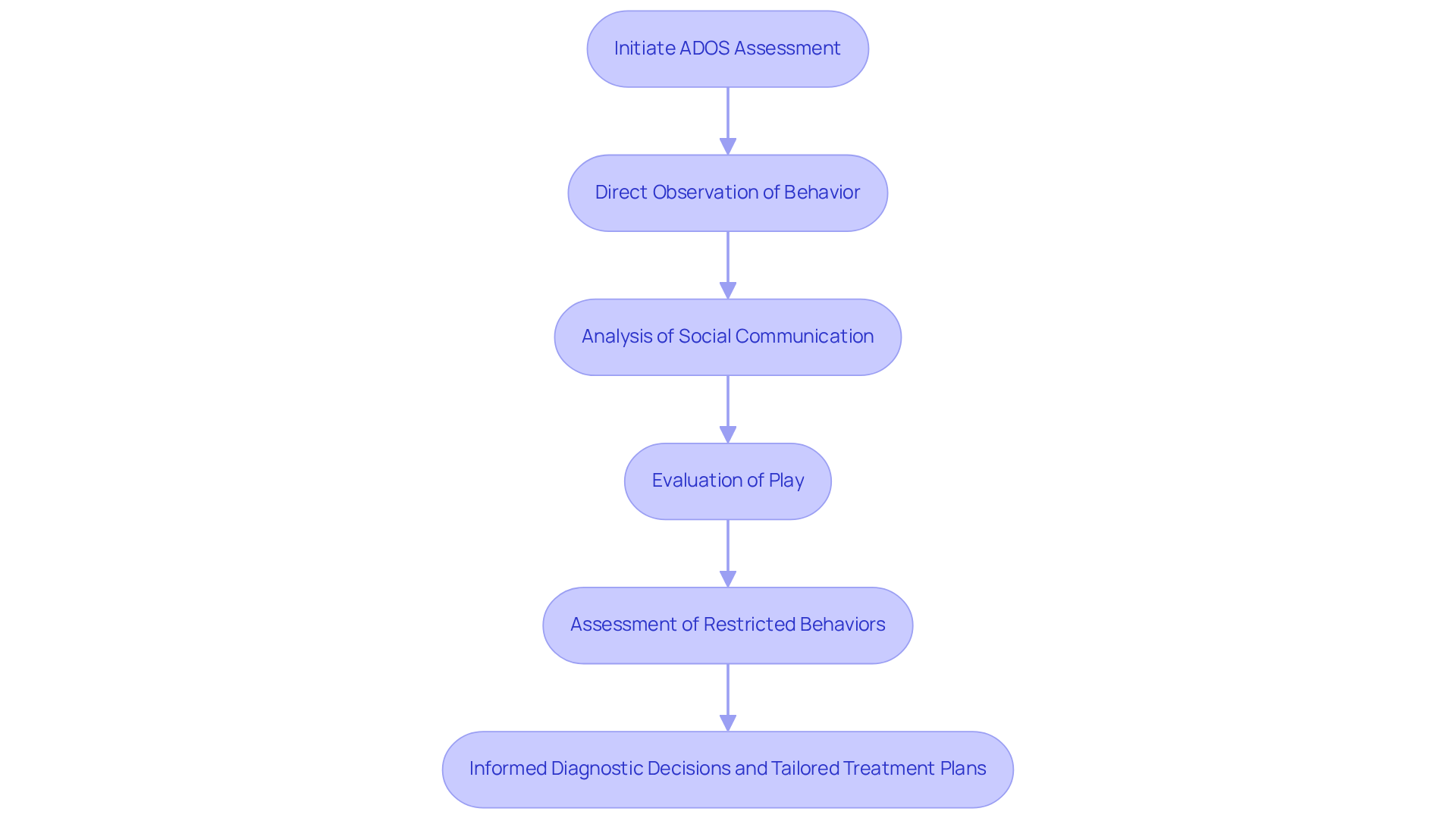
Developmental Behavior Checklist (DBC): Assessing Developmental Issues in Children
The Developmental Behavior Checklist (DBC) serves as a vital resource for assessing behavioral and emotional challenges in youth. This comprehensive tool offers a thorough overview of a young person's growth profile, highlighting areas of concern that may suggest the need for an autism spectrum test child or other developmental disorders. Recent findings underscore the DBC's effectiveness in identifying behavioral issues, revealing that a significant percentage of youth with mental and behavioral disorders (MBDDs) face challenges that the DBC can help uncover.
By utilizing the DBC, professionals gain valuable insights into a young person's strengths and weaknesses, which is crucial for developing targeted interventions tailored to specific growth needs. The DBC not only identifies behavioral issues but also sheds light on growth challenges, establishing itself as an indispensable resource in the autism spectrum test child evaluations. Its practical application illustrates its role in enhancing our understanding of young people's developmental journeys, ultimately leading to improved outcomes through early diagnosis and intervention.
Statistics indicate that the prevalence of MBDDs among individuals aged 3 to 17 years rose from 25.3% in 2016 to 27.7% in 2021, highlighting the increasing need for effective assessment tools like the DBC. As Rebecca T. Leeb, PhD, notes, 'Childhood mental and behavioral disorders (MBDD) are common and are linked to poor health and well-being.' This emphasizes the urgency of employing the DBC in evaluations to address the growing challenges faced by youth with developmental concerns.
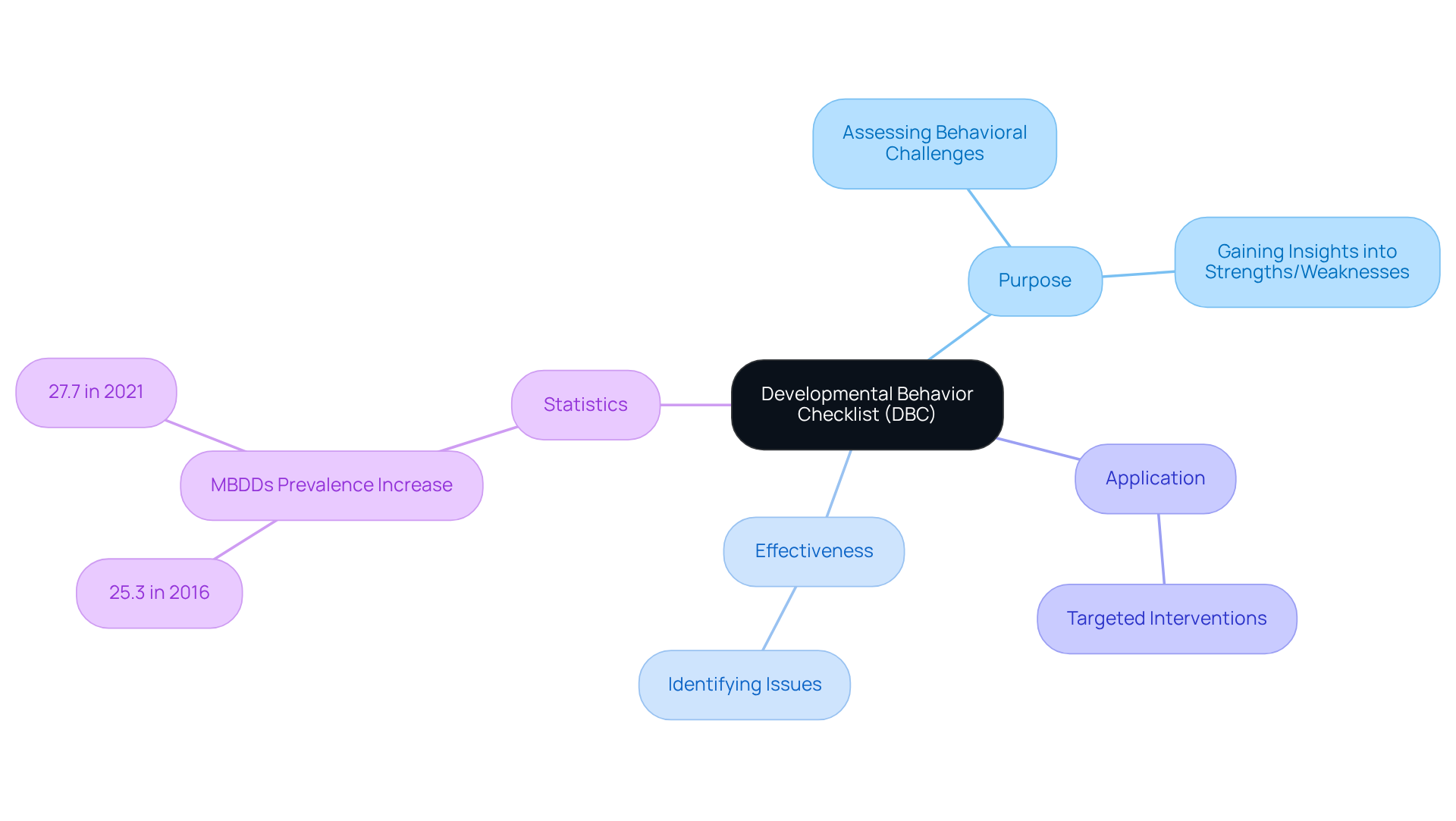
Autism Diagnostic Interview-Revised (ADI-R): In-Depth Developmental Assessment
The Autism Diagnostic Interview-Revised (ADI-R) is a structured interview designed to gather detailed information about a child's developmental history and behavior for the autism spectrum test child. Conducted with parents or caregivers, the ADI-R explores critical areas such as communication, social interaction, and repetitive behaviors. This tool is essential for a thorough evaluation of developmental disorders, offering valuable insights that guide diagnosis and intervention planning.
Research indicates that the ADI-R has an overall sensitivity of 0.75 and specificity of 0.82, making it a reliable tool for identifying spectrum disorders across various populations. Clinicians emphasize the importance of the autism spectrum test child, particularly the ADI-R, in understanding a child's growth journey, enabling specialists to tailor their methods to effectively meet individual needs. As noted by Lord et al., the ADI-R is among the most frequently utilized tools in the behavioral diagnosis of autism.
Moreover, the structured format of the ADI-R aids in collecting developmental history, ensuring that essential information is captured for accurate assessment and planning. Notably, studies have demonstrated that 7 of the 93 items in the ADI-R can classify autism with an impressive 99.9% statistical accuracy. In terms of time commitment, the session duration for the ADI-R typically lasts between 120 and 180 minutes, providing practical context for parents and professionals alike regarding the assessment process.
Ultimately, the ADI-R not only enhances diagnostic accuracy but also plays a crucial role in shaping effective intervention strategies tailored to each child's unique profile, as identified by an autism spectrum test child. By understanding the nuances of this process, parents can feel more empowered and supported as they navigate their child's developmental journey.
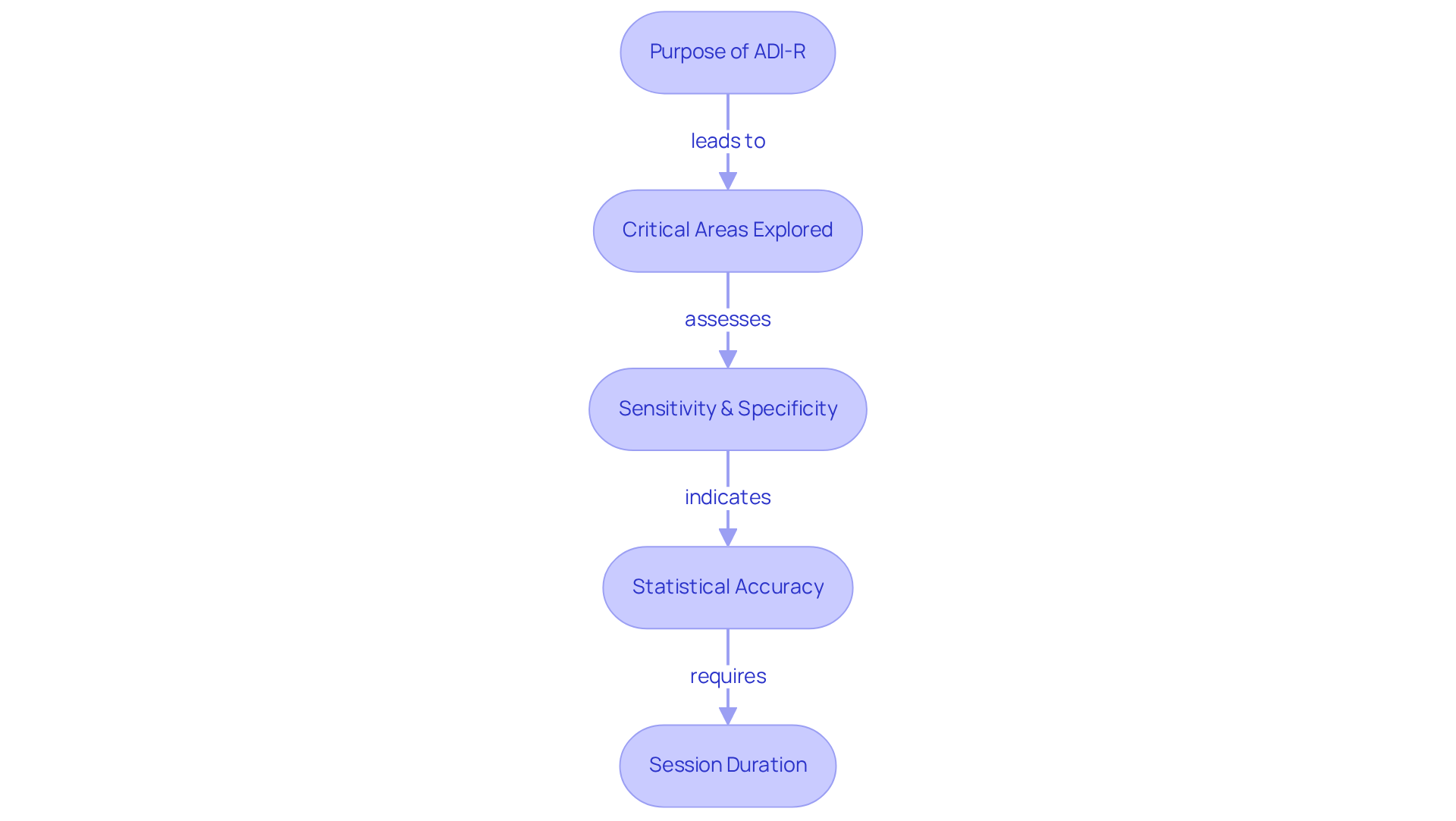
Conclusion
Understanding the tools available for evaluating autism spectrum disorder (ASD) is essential for both parents and professionals. This article highlights nine critical resources that facilitate early detection and comprehensive assessments, ultimately aiming to improve outcomes for children on the spectrum. By utilizing these tools, caregivers can gain valuable insights into their child's unique behaviors and challenges, paving the way for timely interventions and support.
Key instruments such as the M-CHAT-R, AQ, CARS-2, and ADOS play pivotal roles in identifying autism traits and informing treatment strategies. Each tool offers a distinct approach, whether through parent questionnaires, structured observations, or in-depth interviews, reinforcing the importance of a multifaceted evaluation process. With the rising prevalence of autism, these resources become increasingly vital in ensuring early and accurate diagnoses, which can significantly alter a child's developmental trajectory.
As awareness and understanding of autism continue to evolve, embracing these assessment tools is crucial for fostering a supportive environment for children with ASD. Parents and caregivers are encouraged to actively engage with these resources, advocating for their child's needs and seeking the necessary support. Together, by leveraging the power of these essential tools, we can create a brighter future for children on the autism spectrum.
Frequently Asked Questions
What is ASD Media's mission?
ASD Media is committed to enhancing the application of ABA therapy by providing extensive resources and insights for autism spectrum testing. Their mission is to empower parents and professionals with essential tools and strategies to navigate evaluations related to developmental disorders.
What is the M-CHAT-R and its purpose?
The Modified Checklist for Autism in Toddlers, Revised (M-CHAT-R) is a screening tool designed for parents of children aged 16 to 30 months. It consists of 20 targeted questions to identify children at risk for autism, facilitating early detection and timely interventions that can improve developmental outcomes.
How reliable is the M-CHAT-R?
Recent studies show that the M-CHAT-R has a pooled sensitivity of 0.83 and a specificity of 0.94, indicating its reliability for both pediatricians and parents in identifying children at risk for autism.
Why is early detection important?
Early detection through tools like the M-CHAT-R allows for timely access to support services, which are crucial for nurturing social skills and addressing challenging behaviors in children identified as at risk for autism.
What is the Autism Spectrum Quotient (AQ)?
The Autism Spectrum Quotient (AQ) is a self-administered questionnaire that evaluates the extent to which individuals display autistic traits. It is primarily designed for adults but serves as a valuable resource for parents to understand their child's behavior.
How does the AQ help in understanding a child's behavior?
The AQ provides insights into crucial areas such as social skills, communication, and repetitive behaviors, allowing for a deeper understanding of a child's unique profile and helping to create targeted interventions.
What is the significance of the AQ in diagnosing autism?
The AQ demonstrates strong test-retest reliability and high internal consistency, making it a trustworthy tool for assessing traits associated with autism in children aged 4 to 11, which is essential given the rising prevalence of autism spectrum disorder.
What is the current prevalence of autism spectrum disorder in the U.S.?
The prevalence of autism spectrum disorder is 1 in 31 children diagnosed in the U.S., with an overall ASD rate of 27.6 per 1,000 youths aged 8 years.




